PATLABOR THE MOBILE POLICE: THE TV SERIES [1989]
Flash
Gordon (Anime Corner
Staff Writer)
Pioneer Elite Plasma Display
System PDP-5050SX
Denon AV Surround Receiver AVR-1801 with Dolby Digital/ DTS
Boston Acoustics Micro90T Die-Cast Surround Speakers including Subwoofer
Toshiba DVD SD-3755 Player with Dolby Digital/ DTS/ 3D Surround Sound.
SERIES [47 EPISODES]
3+ RATING
B- ANIMATION
A CHARACTER
A- MECH DESIGN
B MUSIC
B+ STORY
B+ SERIES GRADE
STUDIO: SUNRISE
DIRECTOR: NAOYUKI YOSHINAGA
AUTHOR: HEADGEAR
PRODUCER: SUNRISE
ANIMATOR: NOBUYOSHI NISHIMURA [1+5+8+12+17+22+27+34+38+41]/ AKIO TAKAMI [2+6+11+15+20+36+43+47]/ CHUUICHI IGUCHI [3+7+10+14+19+25+29+33]/ ATSUO TOBE [4+9+13+18+21+26+31+35]/ HIROKI TAKAGI [16+23+28+32+39+46]/ KIICHI TAKAOKA [24+30]/ KISARAKA YAMADA [37+42+45]/ SATOSHI ISONO [40]/ TSUKASA DOKITE [44]
DESIGNS: AKEMI TAKADA [character]/ YUTAKA IZUBUCHI/ YOSHINORI SAYAMA [mechanical]/ MASAMI YUKI [manga artist/ creator]
SCRIPT: KAZUNORI ITO [1+2+4+7+10+11+20+21+24+27+28+30+32+33+34+35+44+46+47]/ MAMORU OSHII [3+9+14+29+38]/ HIROYUKI HOSHIYAMA [5]/ NAOTO KIMURA [6+8+13]/ MICHIKO YOKOTE [12+15+17+22+25+26+42+45]/ TETSUKO TAKAHASHI [16+43]/ HIBARI ARISU [18+23+43]/ YUTAKA IZUBUCHI [19]/ NAOYUKI YOSHINAGA [23]/ SATOSHI NAMIKI [31+36+37+39+41]/ SHIGEYOSHI SUGAMA [40]
MUSIC: KENJI KAWAI
THEME SONG: ‘SONO MAMA NO KIMI DE ITE [STAY THE WAY YOU ARE]’ [opening theme] YUKO NITOU [1-34]
‘CONDITION GREEN’ [opening theme] HIROKO KASAHARA [35-47] ‘MIDNIGHT BLUE’ [closing theme] KISS ME QUICK [1-34]
‘PARADISE NO KAKURITSU’ [closing theme] JA-JA [35-47]
DVD EXTRAS: INTRODUCTION TO PATLABOR/ DIRECTOR INTERVIEW/ CHARACTER PROFILES/ ART & SKETCH GALLERY/ BEHIND THE SCENES/ MEET THE SCREENWRITER/ FAN VOICEOVER CONTEST RESULTS/ TRIBUTE TO KANUKA CLANCY/ TRAILERS/ PREVIEWS/ DVD-ROM FEATURES includes: ART GALLERY/ SCRIPTS/ EPISODE SYNOPSIS/ COMPLETE MEET THE DIRECTOR INTERVIEW/ CHARACTERS/ CHARACTER SKETCHES/ CREDITS
|
| DVD
BREAKDOWN |
OTHER
WORKS: |
| REVIEW
(Warning: Spoilers Ahead!) |
“Labor, a robot specifically designed for heavy industrial work. The rise of labors propagated a revolution in industry, but also in criminal activity. The police therefore created a special unit- the patrol labor, and thus the birth of Patlabor.”
-Opening to Patlabor The Mobile Police: The TV Series [1-12]
“AV-98 a.k.a. the Ingram Patrol Labor. 6.02 tons. 8.02 meters high. SCB power. SCLN Drive System. Armed and ready for combat with a 37mm Revolver and Stun Baton. Designed specifically for police use to make a psychological impact on the community. To deter criminals while making the public feel safe.”
-Opening to Patlabor The Mobile Police: The TV Series [13-47]
REVIEW:
Ron Tanner wrote an essay titled Mr. Atomic, Mr. Mercury And Chime Trooper: Japan’s Answer To The American Dream for Asian Popular Culture magazine [1995] which eloquently captured the essence of mecha anime. “Man mounted on machine, a joystick gripped in each hand, was and is the epitome of Japan’s technological dream.” Gender aside, Patlabor The Mobile Police [PTMP] is one of the finest examples of that well-articulated belief.
“Target locked on!” is declared at the end of every preview throughout the series PTMP. Indeed, this is one series you will need to lock onto and into for a good part of your natural life [alright, it’s not Naruto]. Animerica correctly asserts on the DVD case to the original OVA series that otaku will need to “start here and keep going.” They will have a long way to go to be sure. Watching the Patlabor universe is like an unending tour of duty. You may well be exhausted when it’s all said and done, but it’s a lot of fun and for many a labor of love.
It began with the original PTMP OVA [1988]. Before there was Blood: The Last Vampire and Jin Roh: The Wolf Brigade, even before Ghost In The Shell, imaginations were set on fire within the world of anime with the refreshing new mecha angle of PTMP, thanks to the creative mind of Mamoru Oshii. His string of endlessly groundbreaking films and concepts from a wealth of ideas continues inspiring otaku to sit up and 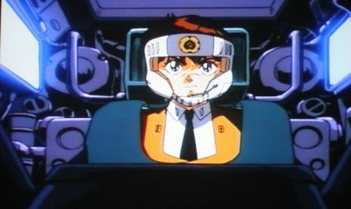 take notice. Tokyo born Oshii [b 1951] began his not-so humble beginnings with Tatsunoko Productions [Gatchaman, Karas]
and followed with a stint at Studio Pierrot. He became the collective figurehead and conspirator to the creative cadre dubbed Headgear, the artistic force behind PTMP. The 7 episode PTMP OVA ushered forth the patrol labor universe. Oshii personally directed episodes 1 through 6. It was a promotional calling card that also advertised his upcoming Patlabor: The Movie [1989]. The OVA was an attempt to force a studio’s hand to pick up the team’s concepts for a long-running TV series. Gaining corporate support for a series initially was problematic, which resulted in the OVA. Eventually, director of Episode 7 of the OVA, Naoyuki Yoshinaga, became the running constant in taking the reins for the inevitable show, PTMP: The TV Series [1989] [PTMP:TTS], which followed the first motion picture. Yoshinaga would be the quintessential artistic heart of the mammoth program. The tone of the series certainly differed from the film, as
take notice. Tokyo born Oshii [b 1951] began his not-so humble beginnings with Tatsunoko Productions [Gatchaman, Karas]
and followed with a stint at Studio Pierrot. He became the collective figurehead and conspirator to the creative cadre dubbed Headgear, the artistic force behind PTMP. The 7 episode PTMP OVA ushered forth the patrol labor universe. Oshii personally directed episodes 1 through 6. It was a promotional calling card that also advertised his upcoming Patlabor: The Movie [1989]. The OVA was an attempt to force a studio’s hand to pick up the team’s concepts for a long-running TV series. Gaining corporate support for a series initially was problematic, which resulted in the OVA. Eventually, director of Episode 7 of the OVA, Naoyuki Yoshinaga, became the running constant in taking the reins for the inevitable show, PTMP: The TV Series [1989] [PTMP:TTS], which followed the first motion picture. Yoshinaga would be the quintessential artistic heart of the mammoth program. The tone of the series certainly differed from the film, as 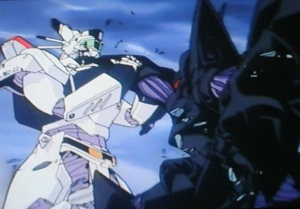 Yoshinaga would take the Patlabor universe more in the direction of the precedent setting OVA and less the entirely dramatic
police procedural style established for the film. Events and introductions vary slightly at the opening of PTMP:TTS compared with the OVA as characters are reintroduced to a television audience. The OVA is a good taster in the run up to the TV series that naturally fleshes out the story lines and characters to much greater detail and success due to the production’s lengthy timeline.
Yoshinaga would take the Patlabor universe more in the direction of the precedent setting OVA and less the entirely dramatic
police procedural style established for the film. Events and introductions vary slightly at the opening of PTMP:TTS compared with the OVA as characters are reintroduced to a television audience. The OVA is a good taster in the run up to the TV series that naturally fleshes out the story lines and characters to much greater detail and success due to the production’s lengthy timeline.
The 47 episode TV series would capture the hearts and minds of otaku everywhere. It generated a fan base for years to come. PTMP:TTS marked another pivotal moment for a generation of anime fans. It was another defining moment where anime achieved certified classic status in the vein of Gatchaman [1972] or Star Blazers [Space Battleship Yamato] [1974], thanks to fan loyalty. It was an impact series evolving anime, pushing the boundaries and opening doors to the art form as the aforementioned series had achieved in their day. PTMP served as a springboard in cultivating the individual careers for those collectively involved as Headgear. So while the original OVA and film gave rise to Patlabor television sealed its reputation and status in anime pop culture and history creating some of the most unforgettable characters to ever grace an animation cel.
So seeds for the long-running 47 episode PTMP:TTS and the 16 episode PTMP: The New Files [1992] [PTMP:TNF] were sown with the original OVA. Both series were capably overseen and directed by chief animator of Episode 7 for the original OVA [SV Units, Go North!], Naoyuki Yoshinaga. He admitted to preferring a less rigid, more flexible approach to directing. “I didn’t want to force a neat ending, with predictable 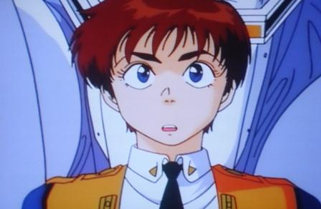 preplanned symmetry.” Yoshinaga was clearly drawn to the project as he explained on the DVD-ROM features of DVD Volume 1 for the TV series. The show allowed for creators to flesh out the universe and characters in a more thoughtful design. In fact, Yoshinaga was the one constant external force outside of Headgear that would see Patlabor through to its natural end. Yoshinaga adds, “What interested me about Patlabor was that the story wasn’t divided simply into good guys versus bad guys, and that the main characters were totally ordinary people.” He insists, “My first goal was creating a piece that the whole Headgear group might have made.” His approach married an extraordinary future world with believable problems, soundly weaving a credible police dramedy grounded in the reality based on Headgear’s vision. There are alternate timelines at work with each series of course [OVA vs. TV series vs. Film vs. Manga]. Ironically, the style and format of the TV series is often referenced as being less animated with action than the manga. Manga creator Masami Yuki confirmed in Animerica [1997], “I think you see more of the Ingram in action in the manga.” Despite the family time slot the program
preplanned symmetry.” Yoshinaga was clearly drawn to the project as he explained on the DVD-ROM features of DVD Volume 1 for the TV series. The show allowed for creators to flesh out the universe and characters in a more thoughtful design. In fact, Yoshinaga was the one constant external force outside of Headgear that would see Patlabor through to its natural end. Yoshinaga adds, “What interested me about Patlabor was that the story wasn’t divided simply into good guys versus bad guys, and that the main characters were totally ordinary people.” He insists, “My first goal was creating a piece that the whole Headgear group might have made.” His approach married an extraordinary future world with believable problems, soundly weaving a credible police dramedy grounded in the reality based on Headgear’s vision. There are alternate timelines at work with each series of course [OVA vs. TV series vs. Film vs. Manga]. Ironically, the style and format of the TV series is often referenced as being less animated with action than the manga. Manga creator Masami Yuki confirmed in Animerica [1997], “I think you see more of the Ingram in action in the manga.” Despite the family time slot the program 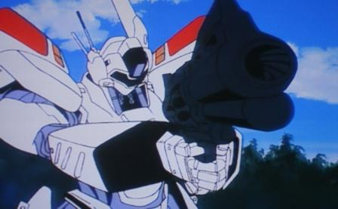 was scheduled to fill it needed to strike the balance appropriate for a younger audience as well as satiate the director’s own creative aspirations. “The stations thought we should lower the age of our target audience. But after giving that some thought, I pretty much did what I wanted
anyway,” believes Yoshinaga. Indeed, the show is a clever mix that walks the line for all ages without sacrificing or sugarcoating the police-related substance found in the strong scriptwriting. Remarkably, the rating [3+] of the show doesn’t accurately reflect the oft-mature nature of the subject matter found in many episodes or the depth and complexity to which it handles emotional issues, law enforcement politics, public relations and interpersonal relations. Much of the substance elevates well over the heads of most kids, but damn they’ll love those labors.
was scheduled to fill it needed to strike the balance appropriate for a younger audience as well as satiate the director’s own creative aspirations. “The stations thought we should lower the age of our target audience. But after giving that some thought, I pretty much did what I wanted
anyway,” believes Yoshinaga. Indeed, the show is a clever mix that walks the line for all ages without sacrificing or sugarcoating the police-related substance found in the strong scriptwriting. Remarkably, the rating [3+] of the show doesn’t accurately reflect the oft-mature nature of the subject matter found in many episodes or the depth and complexity to which it handles emotional issues, law enforcement politics, public relations and interpersonal relations. Much of the substance elevates well over the heads of most kids, but damn they’ll love those labors.
From the moment Officer Noa Izumi inscribes the words [translated] “This is mine,” on the leg of Alphonse, Unit 1, a Patlabor, AV-98 [Advanced Vehicle] Ingram Unit in Episode 3 of the TV series, the table is set. PTMP:TTS is all heart amidst the clashing metal labors in the pursuit of justice. It is filled with quirky, strong-willed, uniquely warm characters that comprise Special Vehicles Second Section Division 2 [SV2], the pulse of the story. It’s unlike any other mecha anime in that it’s not driven by it. PTMP focuses, not on robots, but on the characters and their interaction as a unit  working together as a kind of surrogate family. PTMP:TTS would shatter all archetypes that had been molded and attributed to most mech-based series. The central characters were human and the machines secondary, even beloved Alphonse.
Still, like the best ‘Beauty And The Beast’ stories, there’s a running thread that handles with great sincerity the relationship between young, enthusiastic officer Noa Izumi and her adored labor Alphonse. Establishing that extra-special bond between a girl and her robot is just one of the many ways PTMP:TTS broke with a number of anime traditions. Yes, it’s a subtle love story of sorts and only one of the many layers to this treasured show. The writers injected comedy, drama, political and social commentary and reality-based sci-fi into their extensive creation, all of which catapulted its standing into anime legend.
working together as a kind of surrogate family. PTMP:TTS would shatter all archetypes that had been molded and attributed to most mech-based series. The central characters were human and the machines secondary, even beloved Alphonse.
Still, like the best ‘Beauty And The Beast’ stories, there’s a running thread that handles with great sincerity the relationship between young, enthusiastic officer Noa Izumi and her adored labor Alphonse. Establishing that extra-special bond between a girl and her robot is just one of the many ways PTMP:TTS broke with a number of anime traditions. Yes, it’s a subtle love story of sorts and only one of the many layers to this treasured show. The writers injected comedy, drama, political and social commentary and reality-based sci-fi into their extensive creation, all of which catapulted its standing into anime legend.
While SV2’s many colorful characters are largely concentrated upon as an ensemble, PTMP centers on dedicated, headstrong, righteous and perky labor pilot and police crusader Noa Izumi and her tender affection for her giant labor Alphonse [Unit 1]. While their connection to some may seem slightly unnatural, it is inexplicably special and Noa’s adoration for her inhuman partner grows into love and respect. The Central Park Media [CPM] original OVA box cover sums it up as a “Girl Meets Robot” story. Further, the opening theme to the original OVA captured the fanatical obsession best with those 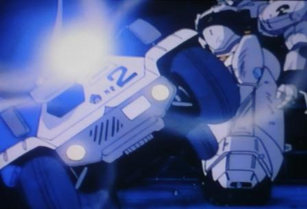 traditionally over-the-top J-Pop lyrics tagging Noa and Alphonse as “technicians of love.” You know the bond between Noa and Alphonse is just a tad bit abnormal with a line like “the way I get flushed at the touch
of your metal body.” Okay. Can you say autoerotic? Claudia Springer coined ‘technoeroticism’ as a “euphoric state of power, excitement, and violence” in Electronic Eros: Bodies And Desire In The Postindustrial Age [1996]. She associates such arousal as the result of mecha clashing in the heat of battle. Her definition touches on an indubitable sexual element with regard to waging war with mecha. She neglects to point out associations for some characters linked to the mere touch of piloting their respective mecha. Nestling inside the cockpit or even laying eyes on a giant robot can be enough in itself. Such elements are certainly not explored or overstated in the kid-friendly world of Patlabor, but a hint of Springer’s description is very relevant even here. Instead this is a more appropriate modern day version of ‘Beauty and the Beast’ or as DVD distributor CPM puts it, “not just another girl-loves-giant-robot movie.” There is indeed a romantic ideal to Noa’s connection with Alphonse.
traditionally over-the-top J-Pop lyrics tagging Noa and Alphonse as “technicians of love.” You know the bond between Noa and Alphonse is just a tad bit abnormal with a line like “the way I get flushed at the touch
of your metal body.” Okay. Can you say autoerotic? Claudia Springer coined ‘technoeroticism’ as a “euphoric state of power, excitement, and violence” in Electronic Eros: Bodies And Desire In The Postindustrial Age [1996]. She associates such arousal as the result of mecha clashing in the heat of battle. Her definition touches on an indubitable sexual element with regard to waging war with mecha. She neglects to point out associations for some characters linked to the mere touch of piloting their respective mecha. Nestling inside the cockpit or even laying eyes on a giant robot can be enough in itself. Such elements are certainly not explored or overstated in the kid-friendly world of Patlabor, but a hint of Springer’s description is very relevant even here. Instead this is a more appropriate modern day version of ‘Beauty and the Beast’ or as DVD distributor CPM puts it, “not just another girl-loves-giant-robot movie.” There is indeed a romantic ideal to Noa’s connection with Alphonse.
As a whole, PTMP is far more complex than simple associations. Noa is skilled, driven, but still maturing transforming from innocent, wide-eyed cadet to thoughtful young woman over the course of the series. Director Yoshinaga knew there was tremendous potential in establishing something special and unexpected with real characters within the mecha genre of anime. “The ultimate goal was to show Noa’s growth over a year in a long-running TV drama. 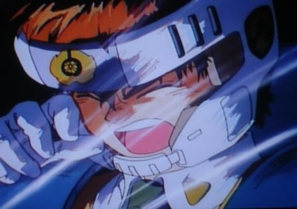 Such character development would be impossible in a shorter medium such as the OVA series or the movie. The staff worked hard to make the most of this opportunity,” explained Yoshinaga on the Volume 1 DVD. Next to our heroine Izumi, there is a wonderful complement of characters with deep fondness for one another. Throughout PTMP Yoshinaga treats these partners as anything but secondary players. They are key cogs in the proverbial wheel throughout the program. Izumi’s partner is Asuma Shinohara, member of the famous Shinohara family. He is Shinohara of Shinohara Heavy Industries [SHI], a company involved in the creation, evolution and advancement of the labor revolution. The use of these labors as part of the fabric of industry created a pilot workforce, which indirectly led to crimes against society. This, in turn, ultimately led to the development and use of the AV-98 Ingram by the police itself to combat these new technology-driven criminal abuses. SHI, while only one such labor company, fashioned a variety of models, chief among them the
AV-98 Ingram for law enforcement. The AV-98 would be implemented by SV2, a special section of the Tokyo Metropolitan Police, to combat labor crime. Asuma Shinohara has a genuine affection for Izumi [Number 1 Forward Ingram Pilot- Unit 1] and backs and coordinates her actions from his Number 1 Backup Command Car. Gentle giant and strongman Hiromi Yamazaki, who enjoys raising chickens and gardening,
Such character development would be impossible in a shorter medium such as the OVA series or the movie. The staff worked hard to make the most of this opportunity,” explained Yoshinaga on the Volume 1 DVD. Next to our heroine Izumi, there is a wonderful complement of characters with deep fondness for one another. Throughout PTMP Yoshinaga treats these partners as anything but secondary players. They are key cogs in the proverbial wheel throughout the program. Izumi’s partner is Asuma Shinohara, member of the famous Shinohara family. He is Shinohara of Shinohara Heavy Industries [SHI], a company involved in the creation, evolution and advancement of the labor revolution. The use of these labors as part of the fabric of industry created a pilot workforce, which indirectly led to crimes against society. This, in turn, ultimately led to the development and use of the AV-98 Ingram by the police itself to combat these new technology-driven criminal abuses. SHI, while only one such labor company, fashioned a variety of models, chief among them the
AV-98 Ingram for law enforcement. The AV-98 would be implemented by SV2, a special section of the Tokyo Metropolitan Police, to combat labor crime. Asuma Shinohara has a genuine affection for Izumi [Number 1 Forward Ingram Pilot- Unit 1] and backs and coordinates her actions from his Number 1 Backup Command Car. Gentle giant and strongman Hiromi Yamazaki, who enjoys raising chickens and gardening, 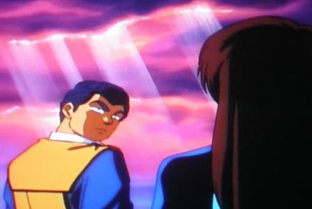 commands the Number 1 Labor Carrier. Trigger-happy, hot head and overzealous Isao Ota is Number 2 Forward Ingram Pilot [Unit 2] for SV2. Formerly with the riot police he gives the words ‘friendly fire’ and ‘armed and dangerous’ new meaning. Ota is prone to fits of irrational behavior, lunacy or flat out rage in his pursuit of justice, but he’s fearless, maybe to a fault [much to the chagrin of insurance companies] and a fan darling. Shoot first, ask questions later [“Let’s go kill it, we can identify it afterwards”] is standard operating procedure for Ota. Kanuka Clancy, Number 2 Backup Command Car, enters the unit as a foreigner on loan brought into assist from New York City’s finest, NYPD. She is the daughter of a Japanese-American father and Japanese mother. Her
parents were murdered, which fueled her desire to pursue a career in law enforcement. She may have an icy cool personality, but she is an unflinching professional, keeping her feelings in check and her colleagues at a distance. The equally qualified Takeo Kumagami eventually replaces her, but with a predisposition for fainting. Mikiyasu Shinshi is the Number 2 Labor Carrier. He is the only married member of SV2 and is often ribbed for being hen-pecked by the wife. The SV2 team is headed by the savvy, investigative genius of sedate, chain-smoking, often ho hum, but wily tactician Captain Kiichi Goto. He is always cool as a cucumber and always makes the right call. The other branch, Special Vehicles Second Section Division 1 [SV1], resides in the same Headquarters [HQ] building. Formidably intelligent Captain Shinobu Nagumo helms SV1. She is Goto’s friendly rival and mental equivalent with whom he secretly and mutually holds romantic feelings. Finally, the well-respected and revered Seitaro Sakaki and his faithful apprentice, the wacky, but brilliant, Shigeo “Shige” Shiba, oversee labor repairs. The group is comprised of big hearts and an abundance of eccentricities to heighten the fun. Together they make up the inner workings of a family of police officers and colleagues assigned to Special Vehicles Second Section. Whether it’s eating ramen noodles or hanging together off-duty, these folks stick together. Humorously and ironically, despite enforcing the law, SV2 is portrayed as a band of law enforcement outcasts [why are they in charge of patrol labor equipment then?] by competing agencies. Still, there’s more to SV2 than meets the eye. Despite the occasionally zany antic or juvenile maneuver, SV2 is often underrated. SV2 may be goofy, but are always loveable and overlooked when rising to the occasion. The trials of this core unit make for some of the best anime programming ever colored to celluloid. PTMP is perennially rewatchable thanks
to the care that went into establishing its fine cast.
commands the Number 1 Labor Carrier. Trigger-happy, hot head and overzealous Isao Ota is Number 2 Forward Ingram Pilot [Unit 2] for SV2. Formerly with the riot police he gives the words ‘friendly fire’ and ‘armed and dangerous’ new meaning. Ota is prone to fits of irrational behavior, lunacy or flat out rage in his pursuit of justice, but he’s fearless, maybe to a fault [much to the chagrin of insurance companies] and a fan darling. Shoot first, ask questions later [“Let’s go kill it, we can identify it afterwards”] is standard operating procedure for Ota. Kanuka Clancy, Number 2 Backup Command Car, enters the unit as a foreigner on loan brought into assist from New York City’s finest, NYPD. She is the daughter of a Japanese-American father and Japanese mother. Her
parents were murdered, which fueled her desire to pursue a career in law enforcement. She may have an icy cool personality, but she is an unflinching professional, keeping her feelings in check and her colleagues at a distance. The equally qualified Takeo Kumagami eventually replaces her, but with a predisposition for fainting. Mikiyasu Shinshi is the Number 2 Labor Carrier. He is the only married member of SV2 and is often ribbed for being hen-pecked by the wife. The SV2 team is headed by the savvy, investigative genius of sedate, chain-smoking, often ho hum, but wily tactician Captain Kiichi Goto. He is always cool as a cucumber and always makes the right call. The other branch, Special Vehicles Second Section Division 1 [SV1], resides in the same Headquarters [HQ] building. Formidably intelligent Captain Shinobu Nagumo helms SV1. She is Goto’s friendly rival and mental equivalent with whom he secretly and mutually holds romantic feelings. Finally, the well-respected and revered Seitaro Sakaki and his faithful apprentice, the wacky, but brilliant, Shigeo “Shige” Shiba, oversee labor repairs. The group is comprised of big hearts and an abundance of eccentricities to heighten the fun. Together they make up the inner workings of a family of police officers and colleagues assigned to Special Vehicles Second Section. Whether it’s eating ramen noodles or hanging together off-duty, these folks stick together. Humorously and ironically, despite enforcing the law, SV2 is portrayed as a band of law enforcement outcasts [why are they in charge of patrol labor equipment then?] by competing agencies. Still, there’s more to SV2 than meets the eye. Despite the occasionally zany antic or juvenile maneuver, SV2 is often underrated. SV2 may be goofy, but are always loveable and overlooked when rising to the occasion. The trials of this core unit make for some of the best anime programming ever colored to celluloid. PTMP is perennially rewatchable thanks
to the care that went into establishing its fine cast.
Welcome to modern day Tokyo. Global warming has caused profound changes to the polar ice caps affecting rising sea levels. An engineering marvel is now underway. A dam has been built around Tokyo Bay. Furthermore, a dyke is being constructed across the bay with plans to drain and convert an area into land use as part of a real estate reclamation scheme. The undertaking is referred to as the Babylon Project. 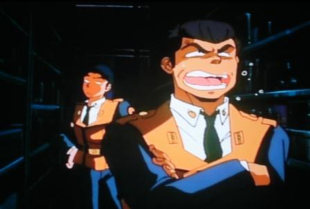 Many environmentalists are unhappy with the program and some have organized terror groups to convey their message. The gigantic construction effort has led to the manufacture of mecha giants known as labors. The ability of the labor to accelerate workloads generated a proliferation of the units for a host of other applications. Again, with the advent of the labor, like any technology, came the advent of a new kind of criminality. The inevitable wave of criminal labor activity began overwhelming the standard Tokyo Metropolitan Police Department, which led to taxpayer funding of SV1 and SV2 and the advancement of the patrol labor [a.k.a. Patlabor]. Division 2 has been paired with the newer AV-98 Ingram model while Division 1 is hampered by an older version. Both are stationed at HQ. HQ is stationed on the docks overlooking the water where our industrious heroes fish for dinner using the police speedboat. Officers
Many environmentalists are unhappy with the program and some have organized terror groups to convey their message. The gigantic construction effort has led to the manufacture of mecha giants known as labors. The ability of the labor to accelerate workloads generated a proliferation of the units for a host of other applications. Again, with the advent of the labor, like any technology, came the advent of a new kind of criminality. The inevitable wave of criminal labor activity began overwhelming the standard Tokyo Metropolitan Police Department, which led to taxpayer funding of SV1 and SV2 and the advancement of the patrol labor [a.k.a. Patlabor]. Division 2 has been paired with the newer AV-98 Ingram model while Division 1 is hampered by an older version. Both are stationed at HQ. HQ is stationed on the docks overlooking the water where our industrious heroes fish for dinner using the police speedboat. Officers 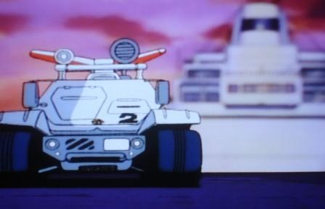 are supplied with offices, mess hall [takeout is generally the order of the day], living quarters, garden, ready room and two hangars [one for each Division’s labors and vehicles]. This is a sterling conceptual, sci-fi mech drama applied to
the problems associated with everyday law enforcement.
are supplied with offices, mess hall [takeout is generally the order of the day], living quarters, garden, ready room and two hangars [one for each Division’s labors and vehicles]. This is a sterling conceptual, sci-fi mech drama applied to
the problems associated with everyday law enforcement.
In order for Headgear to get a ‘green light’ following the original OVA and take the Patlabor concept to the next level, the creators had a tough sell on their hands. There were certain pre-conceived expectations and archetypes associated with anime television in the 1980s and that framework was fairly rigid [today there are many outlets carrying anime]. Headgear wanted to raise the bar from what producers had come to expect. The difficult process is described in the extras on Volume 1 of the TV series. The hard sell wasn’t that the show was a police dramedy with occasional procedural, but that it was helmed by a female lead in Noa Izumi. Such a notion flew in the face of their programming requirements. Furthermore, the mecha element and labor combat was relegated to secondary behind character development topped off with a radically heavy dose of rather ordinary, everyday dilemmas. You could picture a board meeting reluctant to sign off on a mecha show sans the giant robot battles. Now that’s a long shot. It was reasonably sound and sensible science 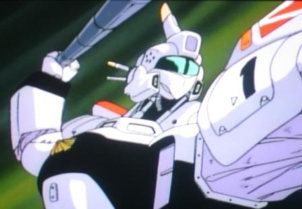 fiction in comparison to standard sci-fi anime set in space. The labor units experienced technical difficulties. The officers tackled issues of romance, frustration, heartache and even punishment. The unit dealt with a morass of external political posturing, bureaucracy, red tape not to mention competing labor manufacturers while simply trying to get their jobs done [talk about reality television]. It was
the hard sell that sold and was embraced by otaku the world over. When hasn’t Mamoru Oshii pushed the boundaries? Oshii has certainly established his credibility since, thanks in part to PTMP and its feature films, which secured his future masterpiece Ghost In The Shell.
fiction in comparison to standard sci-fi anime set in space. The labor units experienced technical difficulties. The officers tackled issues of romance, frustration, heartache and even punishment. The unit dealt with a morass of external political posturing, bureaucracy, red tape not to mention competing labor manufacturers while simply trying to get their jobs done [talk about reality television]. It was
the hard sell that sold and was embraced by otaku the world over. When hasn’t Mamoru Oshii pushed the boundaries? Oshii has certainly established his credibility since, thanks in part to PTMP and its feature films, which secured his future masterpiece Ghost In The Shell.
So what exactly is all this Headgear business? Headgear refers to a loosely organized collective and think-tank of creative minds inside the anime industry. Individually, they are essential talents in each of their respective fields. It was the culmination of these defining talents of four men and one woman. The 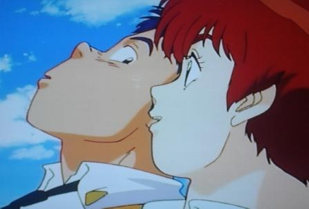 group reference became Headgear, the conceptual author of Patlabor who jointly owns the copyrights to that universe. The designing team is comprised of director Mamoru Oshii, character designer Akemi Takada, manga artist Masami Yuki, writer Kazunori Ito [Ghost In The Shell screenplay] and mechanical designer Yutaka Izubuchi [the conductor-orchestrator of all things mecha in the beautiful Rahxephon]. Headgear first approached Sunrise who turned the concepts down [“not flashy enough”]. It was a blessing in disguise Izubuchi explained in Animerica. “We were lucky that they also declined to buy the rights. If the series ever had been produced, they would have owned it lock, stock and barrel.” So in the end, the rights reverted back to Headgear as a mutual production and that’s how the group came to fruition. In the end, Sunrise did produce/distribute PTMP. Headgear was also consolidated to introduce Patlabor as an animation in which the manga was based upon. Masami Yuki insists, “If Patlabor were to be credited as based on my manga, my publisher Shogakukan would have gotten into the picture, and that would have complicated things. So we decided that the animation should be the primary work, and come out first.”
group reference became Headgear, the conceptual author of Patlabor who jointly owns the copyrights to that universe. The designing team is comprised of director Mamoru Oshii, character designer Akemi Takada, manga artist Masami Yuki, writer Kazunori Ito [Ghost In The Shell screenplay] and mechanical designer Yutaka Izubuchi [the conductor-orchestrator of all things mecha in the beautiful Rahxephon]. Headgear first approached Sunrise who turned the concepts down [“not flashy enough”]. It was a blessing in disguise Izubuchi explained in Animerica. “We were lucky that they also declined to buy the rights. If the series ever had been produced, they would have owned it lock, stock and barrel.” So in the end, the rights reverted back to Headgear as a mutual production and that’s how the group came to fruition. In the end, Sunrise did produce/distribute PTMP. Headgear was also consolidated to introduce Patlabor as an animation in which the manga was based upon. Masami Yuki insists, “If Patlabor were to be credited as based on my manga, my publisher Shogakukan would have gotten into the picture, and that would have complicated things. So we decided that the animation should be the primary work, and come out first.”
PTMP’s longevity is directly linked to the integrity of its writing and its emphasis on character and story. This is why it continues to prosper. Surely, the animation cannot compare with today’s finest studio output, but it is abundant with lovingly hand drawn cels that appeal to fans and still hold up. The 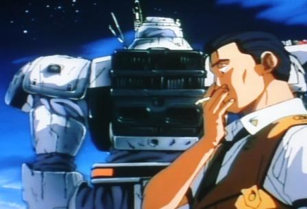 shortcomings in the animation style are a result of the limited number of cels used to express story sequences. There is a much heavier reliance on still shots and freeze frames. Cels are far less in number so movements aren’t nearly as fluid as those found in contemporary anime. Details in the animation are much kinder in tight, close-ups compared with wider establishing shots. Budgetary constraints severely hampered the production value common to the period, but the art that has been injected throughout the ongoing series is quite stunning at times while being considered old-fashioned in the nostalgic vein of early TV anime. Despite the animation limitations, it’s clear it was a labor of love by those involved. It’s a testament to the creators and talent that shaped this timeless original despite financial deficiencies. The character writing is rock solid infusing the program with a colorful cast ideal for repeat viewing. The series ushered forth a new push in the boundary-expanding world of anime marking another defining moment in its evolution. Most of the varied stand alone plots or ongoing story threads are engaging, literate and far more challenging than most American-animated children’s fare.
shortcomings in the animation style are a result of the limited number of cels used to express story sequences. There is a much heavier reliance on still shots and freeze frames. Cels are far less in number so movements aren’t nearly as fluid as those found in contemporary anime. Details in the animation are much kinder in tight, close-ups compared with wider establishing shots. Budgetary constraints severely hampered the production value common to the period, but the art that has been injected throughout the ongoing series is quite stunning at times while being considered old-fashioned in the nostalgic vein of early TV anime. Despite the animation limitations, it’s clear it was a labor of love by those involved. It’s a testament to the creators and talent that shaped this timeless original despite financial deficiencies. The character writing is rock solid infusing the program with a colorful cast ideal for repeat viewing. The series ushered forth a new push in the boundary-expanding world of anime marking another defining moment in its evolution. Most of the varied stand alone plots or ongoing story threads are engaging, literate and far more challenging than most American-animated children’s fare.
The quality of the episodes for PTMP varies slightly across the spectrum from series to series and from episode to episode, not only in animation, but also in 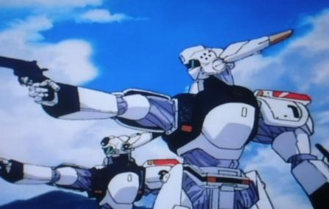 script. There are many writers and animators involved changing hands with each episode. With the exception of a few episodes, specifically noted in Volume 11 of the TV Series, animation quality is consistently good overall. Some episodes truly shine, while just a few others feel disastrously rushed. Perhaps if budget and planning were streamlined into fewer episodes than the quality wouldn’t have suffered under the weight of quantity. It is without a doubt dated by today’s standards given the finite cel numbers, but solid overall given the length of its run and financial limitations. The color palette is fairly crisp on the whole especially for transfers from 1988, 1989 and 1992. There is some print dirt and video jiggle as one might expect from a series of this age, but it’s not distracting
script. There are many writers and animators involved changing hands with each episode. With the exception of a few episodes, specifically noted in Volume 11 of the TV Series, animation quality is consistently good overall. Some episodes truly shine, while just a few others feel disastrously rushed. Perhaps if budget and planning were streamlined into fewer episodes than the quality wouldn’t have suffered under the weight of quantity. It is without a doubt dated by today’s standards given the finite cel numbers, but solid overall given the length of its run and financial limitations. The color palette is fairly crisp on the whole especially for transfers from 1988, 1989 and 1992. There is some print dirt and video jiggle as one might expect from a series of this age, but it’s not distracting
PTMP character, vehicle and labor designs were also landmark accomplishments generating memorabilia, collectibles, design and sketchbooks, plastic model and resin garage kits [Bandai Master Grade], action figures [Koyaido Revoltech] and even a Bandai Hot Wheels version of the Backup Command Car. The proliferating franchise was evidence to the craftsmanship of these reality-grounded designs that have endured as mainstays in the mecha anime pop culture. The pensive design stage culminated complements of mechanical designer Yutaka Izubuchi and the AV-98 Ingram. Izubuchi’s handiwork 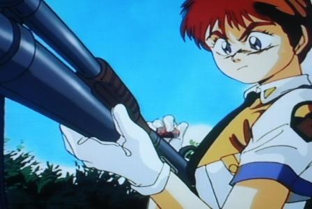 has been a cornerstone for the different incarnations of Patlabor from beginning to end. Izubuchi recollected the seeds of his labor-intensive work in Animerica [1994]. “I started getting comments from onlookers while I was designing, ‘hey, that looks cool’ to which I would reply, ‘Huh? Don’t you think it looks a little bit silly?’” He recalled, “The original idea for Patlabor was very different from the Patlabor you see today.” Fortunately Izubuchi relented to those first impressions and the reactions of the day. From the traditional ‘good guy’ white metal of the Patlabors, to the zippy durability of the white, compact Command Cars complete with flashing red lights, to the massive transport Labor Carriers themselves his mech designs are superior complete with a touch of police realism.
These BIG Ingram labors, at 6.02 tons [6.62 fully armed] and 8.02 meters high, are relatively lightweight and dexterous in the labor world. They are matched by even BIGGER guns and come complete with specialized hidden leg compartments for the labor’s 37mm 6 shot revolver cannon, 90mm riot cannon and anti-labor stun baton as the unit’s weapons of choice. The labor arms are also designed
has been a cornerstone for the different incarnations of Patlabor from beginning to end. Izubuchi recollected the seeds of his labor-intensive work in Animerica [1994]. “I started getting comments from onlookers while I was designing, ‘hey, that looks cool’ to which I would reply, ‘Huh? Don’t you think it looks a little bit silly?’” He recalled, “The original idea for Patlabor was very different from the Patlabor you see today.” Fortunately Izubuchi relented to those first impressions and the reactions of the day. From the traditional ‘good guy’ white metal of the Patlabors, to the zippy durability of the white, compact Command Cars complete with flashing red lights, to the massive transport Labor Carriers themselves his mech designs are superior complete with a touch of police realism.
These BIG Ingram labors, at 6.02 tons [6.62 fully armed] and 8.02 meters high, are relatively lightweight and dexterous in the labor world. They are matched by even BIGGER guns and come complete with specialized hidden leg compartments for the labor’s 37mm 6 shot revolver cannon, 90mm riot cannon and anti-labor stun baton as the unit’s weapons of choice. The labor arms are also designed 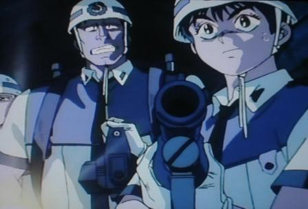 with special extensions for reach, which come in handy. All features sensibly lend themselves to the functionality of real world design. Those shoulder-installed, flashing red siren built-ins are an exquisite example of the careful blueprint that went into the labor’s design alongside police badge, license information and patrol colors that adorn all of SV2’s equipment. Cockpit sequences further illustrate the relationship between pilot and labor. Elsewhere, character designs lent long-term weight and stature to the legacy of the program’s many wonderful officers. The uniform designs for SV2 remain a signature for the series with those classic, standard issue orange vests and black ties, and when on assignment topped off by white, helmet-like headgear. These defining trademark images are marvelously warm and graced with the feminine touch of Akemi Takada. Every aspect of the creative team’s imagination is poured forth into the memorable characters and the vision of a Tokyo living in harmony and sometimes disharmony with robot evolution kept in check by SV2. The show benefited from the meticulous attention given to character and design that so many shows discard and leave destined for failure.
with special extensions for reach, which come in handy. All features sensibly lend themselves to the functionality of real world design. Those shoulder-installed, flashing red siren built-ins are an exquisite example of the careful blueprint that went into the labor’s design alongside police badge, license information and patrol colors that adorn all of SV2’s equipment. Cockpit sequences further illustrate the relationship between pilot and labor. Elsewhere, character designs lent long-term weight and stature to the legacy of the program’s many wonderful officers. The uniform designs for SV2 remain a signature for the series with those classic, standard issue orange vests and black ties, and when on assignment topped off by white, helmet-like headgear. These defining trademark images are marvelously warm and graced with the feminine touch of Akemi Takada. Every aspect of the creative team’s imagination is poured forth into the memorable characters and the vision of a Tokyo living in harmony and sometimes disharmony with robot evolution kept in check by SV2. The show benefited from the meticulous attention given to character and design that so many shows discard and leave destined for failure.
If Oshii set the artistic standard for the original OVA for PTMP, Naoyuki Yoshinaga exceeded expectations by maintaining a high standard throughout its TV cycle leading to the second OVA [16 episodes] entitled PTMP:TNF. Most importantly, Volume 1 opens with a rousing four-part conclusion to the 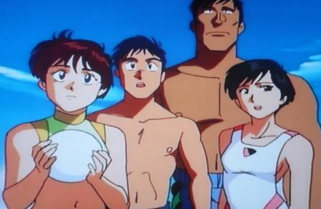 Schaft-Griffin saga left open-ended with the TV Series, while delivering more self-contained tales on the characters of SV2 for the Patlabor faithful. Yoshinaga discussed the series’ objectives succinctly on the DVD-ROM features of the Volume 1 DVD for PTMP:TTS. “One aim of the new OVA series was to give the staff the opportunity to create whatever they wanted.” The flavor of the series, apart from the four-part finale to the Griffin saga that introduces the second OVA, truly exhibits those artistic freedoms and ambitions. “The new OVA episodes were slowly developed by individual staff members. The resulting group of works is extremely rich and varied.” It’s like a creative love letter by the staff for the staff. “Everyone had free rein. We wanted to let the staff that had grown up with the TV series have their own way.” Creative autonomy is clearly on display and the results are mostly hit rather than miss. Some ideas are exceptional with only a few missing the mark during the execution phase. Animation is solid once again with a more liberal use of mild profanity, which certainly impacted the 13+ rating increase for this second OVA series. The one major pitfall: CPM ran into tough times financially and opted to dub only the first four episodes of PTMP:TNF. This left the remaining twelve episodes in Japanese with
subtitles only. It shortchanges the viewer and the English voice cast taking such a long ride.
Schaft-Griffin saga left open-ended with the TV Series, while delivering more self-contained tales on the characters of SV2 for the Patlabor faithful. Yoshinaga discussed the series’ objectives succinctly on the DVD-ROM features of the Volume 1 DVD for PTMP:TTS. “One aim of the new OVA series was to give the staff the opportunity to create whatever they wanted.” The flavor of the series, apart from the four-part finale to the Griffin saga that introduces the second OVA, truly exhibits those artistic freedoms and ambitions. “The new OVA episodes were slowly developed by individual staff members. The resulting group of works is extremely rich and varied.” It’s like a creative love letter by the staff for the staff. “Everyone had free rein. We wanted to let the staff that had grown up with the TV series have their own way.” Creative autonomy is clearly on display and the results are mostly hit rather than miss. Some ideas are exceptional with only a few missing the mark during the execution phase. Animation is solid once again with a more liberal use of mild profanity, which certainly impacted the 13+ rating increase for this second OVA series. The one major pitfall: CPM ran into tough times financially and opted to dub only the first four episodes of PTMP:TNF. This left the remaining twelve episodes in Japanese with
subtitles only. It shortchanges the viewer and the English voice cast taking such a long ride.
Episode highlights from the vast expanse of PTMP include Labor X-10, Out Of Control heavy on labor action as Alphonse and Unit 2 hunt down a rogue military labor. Ota’s Afternoon Of Puzzlement is pure romantic drama and character-driven genius thanks to writer Michiko Yokote. The episode paints a beautiful portrait of Ota’s heart underneath his macho exterior and makes a strong statement about the people we think we know. There’s more to him than meets the eye. The Shadow Of Geo-Front pits Patlabor against monster in a traditional ‘kaiju’-styled Japanese thriller. It’s an expertly penned story by mech designer Yutaka Izubuchi. Surprisingly and noteworthy, it is his only screenwriting credit to the series. Eve’s Trap and Return Of The Phantom are highlights within a thrilling story arc involving SV2 versus The Phantom labor [a Schaft creation]. It’s an ongoing nail biter much like SV2’s battle with The Griffon which evolves from the seeds of The Phantom plotline. SV2 versus Schaft Enterprises’ Griffon 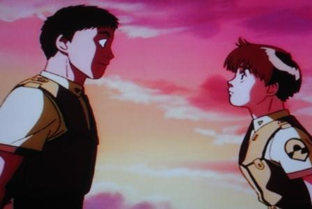 labor is another long-running serial that features many subplots and character associations. It is multi-layered and riveting as it builds upon plot points and tensions. Indubitably, The Griffon is Alphonse’ number one arch nemesis along with manufacturer Schaft Enterprises. The Griffon gives new meaning to ‘getting the Schaft’ with its hulking mass and traditional ‘bad guy’ black complete with flight propulsion system and talon-like fingertips. It’s pure, ominous power. To say it’s a slugfest is an understatement. It’s an engaging cat and mouse thread between good and evil. Tragedy In The Rain and The Fall Of Griffon! are rousing standouts in the saga. Remember, the Griffon storyline actually wraps up with the first four episodes of PTMP:TNF and are four of the strongest from the 16 episode OVA. Additionally, a classic from the TV series is The Underground Mystery Tour. It features some smashingly effective animation [a striking use of blue for effect] and the writing and humor is strong [penned by Mamoru Oshii]. The episode was so good in fact, an exceptionally worthy sequel was written for PTMP:TNF titled The Dungeon Again. It may be the best episode of that second OVA set. The TV series finishes strong with the emotional two-part farewell, His Name Is Zero and Condition Green, focusing on the story’s key protagonist, Noa, and some special moments with her father. It offers terrific closure to an unforgettable series, especially when you learn where Noa obtained the name Alphonse and where her loyalty is derived. There are certainly many more hits than misses [the parody episode Long Live CLAT is cringe-worthy]. Of course, episodic analysis is subjective and you’ll need to see them for yourself.
labor is another long-running serial that features many subplots and character associations. It is multi-layered and riveting as it builds upon plot points and tensions. Indubitably, The Griffon is Alphonse’ number one arch nemesis along with manufacturer Schaft Enterprises. The Griffon gives new meaning to ‘getting the Schaft’ with its hulking mass and traditional ‘bad guy’ black complete with flight propulsion system and talon-like fingertips. It’s pure, ominous power. To say it’s a slugfest is an understatement. It’s an engaging cat and mouse thread between good and evil. Tragedy In The Rain and The Fall Of Griffon! are rousing standouts in the saga. Remember, the Griffon storyline actually wraps up with the first four episodes of PTMP:TNF and are four of the strongest from the 16 episode OVA. Additionally, a classic from the TV series is The Underground Mystery Tour. It features some smashingly effective animation [a striking use of blue for effect] and the writing and humor is strong [penned by Mamoru Oshii]. The episode was so good in fact, an exceptionally worthy sequel was written for PTMP:TNF titled The Dungeon Again. It may be the best episode of that second OVA set. The TV series finishes strong with the emotional two-part farewell, His Name Is Zero and Condition Green, focusing on the story’s key protagonist, Noa, and some special moments with her father. It offers terrific closure to an unforgettable series, especially when you learn where Noa obtained the name Alphonse and where her loyalty is derived. There are certainly many more hits than misses [the parody episode Long Live CLAT is cringe-worthy]. Of course, episodic analysis is subjective and you’ll need to see them for yourself.
The soundtrack to the PTMP TV series and OVAs is immense. The instrumental accompaniments are either a delight, while other selections surely forgettable. For a sweet collection of vocal J-Pop Patlabor Complete Vocal Collection [1993] is a nice jumping off point or Patlabor Singles Collection [1992] as another alternative. Artists are varied but the singles are a lot of fun for that stroll down memory lane. In 2006, the Patlabor music was revisited and digitally remastered in Japan. Six volumes were released featuring vocal selections and instrumental highlights from the extensive series. Those titles include volumes 1 through 6 consecutively: Interface, Intercept, Intermission, “Infinity”, “Inquest” and “Intention”. The packages together contain over 80 tracks and are beautifully compiled. Patlabor fans take note.
Technically CPM could have improved upon its DVD plans. It lacks the same pristine treatment that was afforded CPM’s own 2 DVD Grave Of The Fireflies. There is occasional dirt and video jiggle as one might expect from a series this age. The visual and audio presentations for this wonderful series could have benefited significantly from the proper 5.1 remix and remaster application. Audio on the menu options is 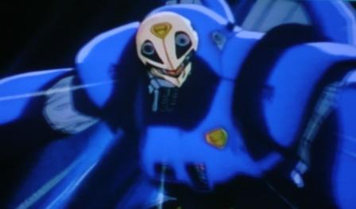 corrected following Volume 1 of the TV series. Both OVAs and PTMP: The TV Series are worthy recipients of the remix and remaster detailing. It would go a long way to restoring the series to a glory it deserves. Removing the occasional anime screen jiggle and adding a new audio mix, similar to the remastering performed on Neon Genesis Evangelion, would have been welcomed. That said, the packaging presentation is good and the transfer is still nice enough to make the experience a pleasurable one. It’s more vibrant than ever on DVD [blues and oranges shine] and is recommended apart from these minor technical shortcomings. Fortunately, Patlabor: The Movie and Patlabor 2: The Movie, both by Mamoru Oshii, have received the director’s cut, 5.1 channel remastering and new English translations with collector’s books. PTMP:TTS would have benefited significantly, but it clearly may not have been cost effective for CPM. The program’s English dub is superior thanks to the voice talents of Elisa Wain as Noa Izumi, Jack Beam as Asuma Shinohara, James Wolfe as Isao Ota and a deadpanning Michael Schwartz as Captain Goto. These steady, exquisitely cast vocal talents raise the bar of the anime series and it ranks up there with the same class afforded Gatchaman as dubbed in America under the infamously edited title of Battle Of The Planets. PTMP:TTS DVD releases highlight a number of fine supplemental extras [just not enough] including Behind The Scenes featuring interviews with Elisa Wain, Michael Schwartz, James Wolfe and older brother Gregory Wolfe [the voice of Yamazaki] serving up a candid, sometimes hilariously wacky look at the dubbing process. There are also terrific bits like Meet The Screenwriter, which lend real insights into the writing process for the anime scripter. An interview with screenwriter Michiko Yokote [one of the show’s best] is exceptional spotlighting her
involvement with the Patlabor universe. She explains that her love for the series actually led her to pen a number of Patlabor novels. Subjects include the trials and tribulations of a retired Captain Goto and his past, Goto’s niece and Noa undercover, a closer look at Asuma and his estranged father’s relationship and more [Syntax Error, Fathers And Sons, Eine Kleine Hong Kong, Third Mission, Blackjack]. Another highlight is a peak at the anime convention circuit circa Icon in New York for the Fan Voiceover Contest Results. It is terrific fun seeing real otaku with real dreams fueled by their love for anime compete to win a spot as a voice actor. The winner scored a role for one of Patlabor’s greatest moments, Ota’s Afternoon Of Puzzlement. With 11 Volumes released for the TV series, additional supplements revisiting this series’ creators, voice cast and more was truly required.
corrected following Volume 1 of the TV series. Both OVAs and PTMP: The TV Series are worthy recipients of the remix and remaster detailing. It would go a long way to restoring the series to a glory it deserves. Removing the occasional anime screen jiggle and adding a new audio mix, similar to the remastering performed on Neon Genesis Evangelion, would have been welcomed. That said, the packaging presentation is good and the transfer is still nice enough to make the experience a pleasurable one. It’s more vibrant than ever on DVD [blues and oranges shine] and is recommended apart from these minor technical shortcomings. Fortunately, Patlabor: The Movie and Patlabor 2: The Movie, both by Mamoru Oshii, have received the director’s cut, 5.1 channel remastering and new English translations with collector’s books. PTMP:TTS would have benefited significantly, but it clearly may not have been cost effective for CPM. The program’s English dub is superior thanks to the voice talents of Elisa Wain as Noa Izumi, Jack Beam as Asuma Shinohara, James Wolfe as Isao Ota and a deadpanning Michael Schwartz as Captain Goto. These steady, exquisitely cast vocal talents raise the bar of the anime series and it ranks up there with the same class afforded Gatchaman as dubbed in America under the infamously edited title of Battle Of The Planets. PTMP:TTS DVD releases highlight a number of fine supplemental extras [just not enough] including Behind The Scenes featuring interviews with Elisa Wain, Michael Schwartz, James Wolfe and older brother Gregory Wolfe [the voice of Yamazaki] serving up a candid, sometimes hilariously wacky look at the dubbing process. There are also terrific bits like Meet The Screenwriter, which lend real insights into the writing process for the anime scripter. An interview with screenwriter Michiko Yokote [one of the show’s best] is exceptional spotlighting her
involvement with the Patlabor universe. She explains that her love for the series actually led her to pen a number of Patlabor novels. Subjects include the trials and tribulations of a retired Captain Goto and his past, Goto’s niece and Noa undercover, a closer look at Asuma and his estranged father’s relationship and more [Syntax Error, Fathers And Sons, Eine Kleine Hong Kong, Third Mission, Blackjack]. Another highlight is a peak at the anime convention circuit circa Icon in New York for the Fan Voiceover Contest Results. It is terrific fun seeing real otaku with real dreams fueled by their love for anime compete to win a spot as a voice actor. The winner scored a role for one of Patlabor’s greatest moments, Ota’s Afternoon Of Puzzlement. With 11 Volumes released for the TV series, additional supplements revisiting this series’ creators, voice cast and more was truly required.
CPM claims the final 12 episodes of PTMP: TNF were the “fan-preferred” sub versions. It’s much more likely CPM ran into financial trouble and ran out of steam dubbing the series. What fans prefer it? Give us names. Why all of a sudden these episodes out of both OVAs and the TV series? There’s no question CPM attempts the easy out here. The fact of the matter is there was a legitimate struggle to finish dubbing 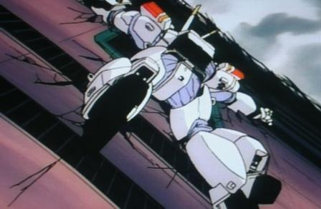 the series. Financial issues offer the only explanation why the final 12 episodes of PTMP: TNF were released in Japanese only without the English voiceovers. Anime Insider reported in August 2006, “The demise of CPM is exaggerated.” That said, the company was clearly hit hard. “CPM, one of the oldest anime distributors in America, laid off a large number of its employees in June. The cutbacks were traced primarily to the woes of…Musicland.” The music retailer “Filed bankruptcy in January leaving a lot of anime companies short on the funds Musicland owed them,” and therein lays one theory as to why PTMP: TNF was never completed with an English dub. While PTMP was being prepared, time and money were running out. CPM co-founder John O’Donnell admitted; “We lost a very important retailer. That loss led CPM to cut a number of positions.” Such evidence would suggest economic factors might have played a part. Fortunately CPM may have been down but they were not knocked out. It’s a shame CPM never finished, because the English voice cast was sensational throughout the series and the actors were left unable to complete the English translation for those other fans [English dub-preferred otaku]. Still, given the hardships the industry has endured, CPM navigated some difficult waters to produce a solid collection for fans of Patlabor.
the series. Financial issues offer the only explanation why the final 12 episodes of PTMP: TNF were released in Japanese only without the English voiceovers. Anime Insider reported in August 2006, “The demise of CPM is exaggerated.” That said, the company was clearly hit hard. “CPM, one of the oldest anime distributors in America, laid off a large number of its employees in June. The cutbacks were traced primarily to the woes of…Musicland.” The music retailer “Filed bankruptcy in January leaving a lot of anime companies short on the funds Musicland owed them,” and therein lays one theory as to why PTMP: TNF was never completed with an English dub. While PTMP was being prepared, time and money were running out. CPM co-founder John O’Donnell admitted; “We lost a very important retailer. That loss led CPM to cut a number of positions.” Such evidence would suggest economic factors might have played a part. Fortunately CPM may have been down but they were not knocked out. It’s a shame CPM never finished, because the English voice cast was sensational throughout the series and the actors were left unable to complete the English translation for those other fans [English dub-preferred otaku]. Still, given the hardships the industry has endured, CPM navigated some difficult waters to produce a solid collection for fans of Patlabor.
There is much to uncover and decipher within the complex and layered world of Patlabor. PTMP is filled with laughter, love, passion and pain, plus labors combined with intrigue, action, mystery and the occasional ‘kaiju.’ Godzilla would be proud. PTMP is a genuinely entertaining anime series from start to finish in all of its manifestations, but the TV series truly develops the concept, story and characters to its full potential. The clash of cold metal aside, this production is packed with warmth, heart and humor and is distinctly original in its presentation within the mecha genre. If synthetic fluids weren’t pumping through Alphonse’ gears and pistons you’d swear there was blood in there. Deftly scripted episodes, either self-contained or arcing over the course of the series, comprise a program that has stood the test of time and will no doubt endure as part of any anime collection. Episodes run the gamut from the silly to the sublime to the complicated. With all its goofy likeability, the show is not just for children, but certainly accessible enough for them to watch too [you’ll need to downplay Goto’s nasty old smoking habit]. Masami Yuki was once asked by Animerica, “What would you say is the main appeal of Patlabor? The characters? The action? The comedy? …The conflict between characters?” His succinct, well-articulated response, “I wonder. The fun is observing the cast as a whole. The fun is observing that phenomenon.”
After experiencing the many special exchanges throughout, PTMP will no doubt hold a special place in your heart. Despite some fine labor action, if it’s non-stop mecha action you want you’ve come to the wrong place. This series is grounded in the relationships that populate a wonderful team of misfits. It’s those memorable characters. These could easily be people you know and that’s the greatest compliment you can give to the writers. It is arguably one of the most original and best sci-fi anime series ever created. Noa remained loyal and true to her love for Alphonse and so will you. If you haven’t seen Patlabor give it a shot. If you’ve seen it before lock back on and fall in love all over again.
Catching up with Noa, Alphonse and the gang is like reconnecting with old friends.
TV SERIES EPISODE GUIDE:
Volume 1
Ep 1: Ingram Activated! [B-]
Ep 2: Kanuka Appears! [B-]
Ep 3: Special Vehicles Department 2 [B]
Ep 4: Go To Demon Mountain! [A-]
Episode 5: Labor X-10, Out Of Control! [A]
Volume 2
Episode 6: The Tower: SOS [A-]
Episode 7: The New Model 97 [B]
Episode 8: The Green Phantom [B]
Episode 9: Red Labor Landing [B-]
Episode 10: Eve’s Trap [A-]
Volume 3
Episode 11: Eve’s Shudder [A-]
Episode 12: Ota’s Afternoon Of Puzzlement [A]
Episode 13: Please Be Generous, Your Highness! [C+]
Episode 14: You Win! [B]
Volume 4
Episode 15: The Whale That Sang A Song [C+]
Episode 16: The Division Crosses The Sea [C+]
Episode 17: Target: Captain Goto [B]
Episode 18: I Love You, Miss Noa! [B-]
Volume 5
Episode 19: The Shadow Of Geo-Front [A]
Episode 20: Dark Troubles Rising [B+]
Episode 21: Return Of The Phantom [A]
Episode 22: Flowers And Labors [C+]
Volume 6
Episode 23: Kanuka’s Report [B-]
Episode 24: Farewell, Kanuka [B-]
Episode 25: Spring Storm [B]
Episode 26: I’m Takeo Kumagami [B+]
Volume 7
Episode 27: A Voice In The Darkness [B]
Episode 28: “The Suspicious Pair” [C+]
Episode 29: The Destruction Of Special Vehicles, Second Section! [C-]
Episode 30: The Griffon Has Arrived! [B]
Volume 8
Episode 31: Tragedy In The Rain [B+]
Episode 32: Reunion [B]
Episode 33: The Dogs Of Schaft [B]
Episode 34: Battle At The Castle Gate [B+]
Volume 9
Episode 35: The Fall Of Griffon! [A-]
Episode 36: Noa’s Big Adventure [C+]
Episode 37: I’m Selling Peace Of Mind [C+]
Episode 38: The Underground Mystery Tour [A]
Volume 10
Episode 39: Economy Model Plans [B]
Episode 40: Orders Of The Coast Guard [B-]
Episode 41: Save The Terrorists [B]
Episode 42: The Men Who Returned [C]
Volume 11
Episode 43: The Working Girl [D]
Episode 44: Long Live CLAT [C]
Episode 45: Vocational Options [B]
Episode 46: His Name Is Zero [B+]
Episode 47: Condition Green [A]
CHARACTERS:
NOA IZUMI
ASUMA SHINOHARA
ISAO OTA
CAPTAIN KIICHI GOTO
KANUKA CLANCY
HIROMI YAMAZAKI
SHINOBU NAGUMO
MIKIYASU SHINSHI
SEITARO SAKAKI
SHIGEO ‘SHIGE’ SHIBA
TAKEO KUMAGAMI
LABORS:
AV-98 Ingram Unit 1 [Alphonse]
AV-98 Ingram Unit 2
AV-98 Ingram Unit 3
AV-Zero
Mark II Economy Model
The Griffon
The Phantom
Helldiver
Brocken
Pyro-Buster
Grau Bear
Crabman
Frogman
Saturn [SRX-70/ SR-70]
